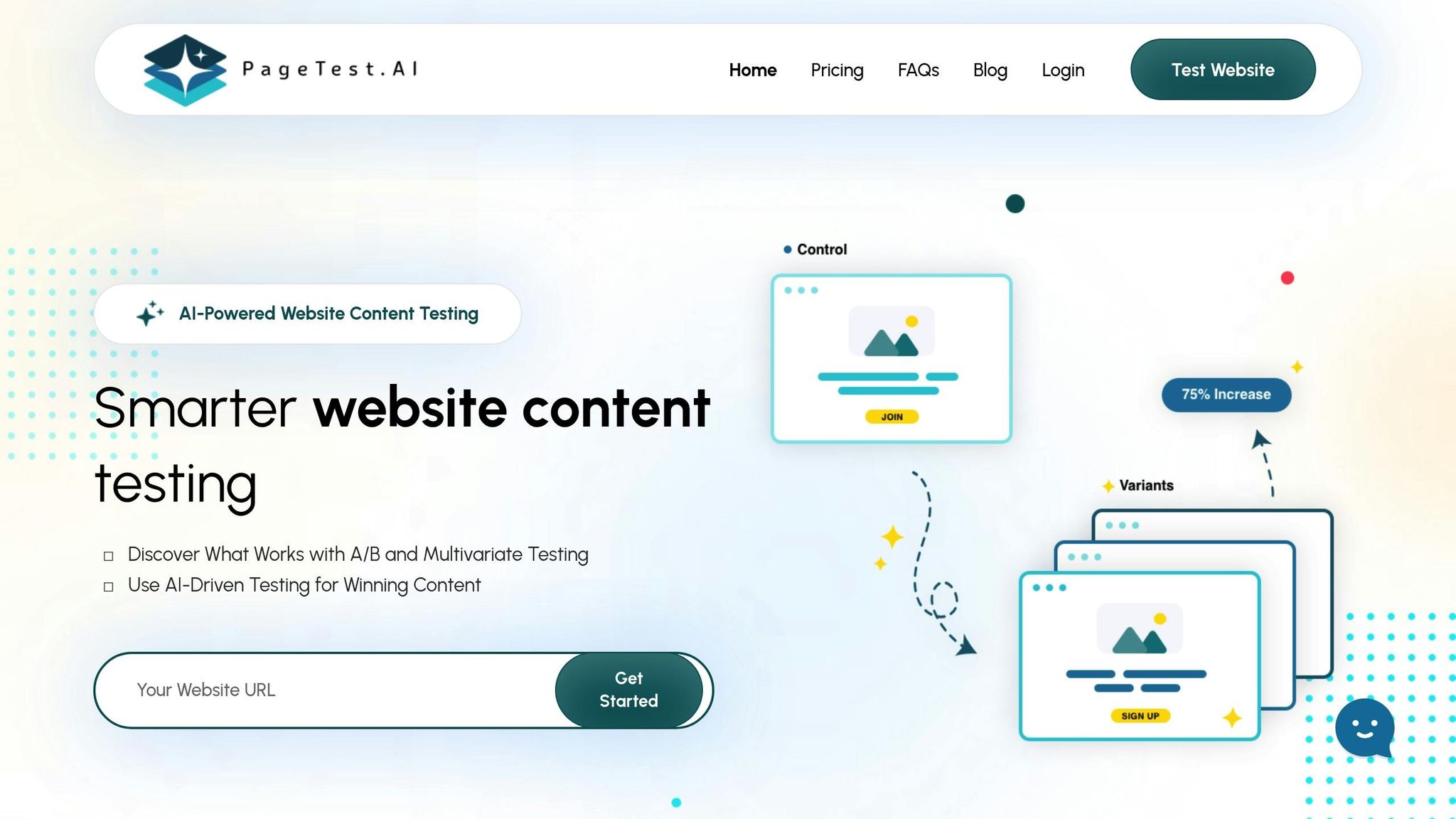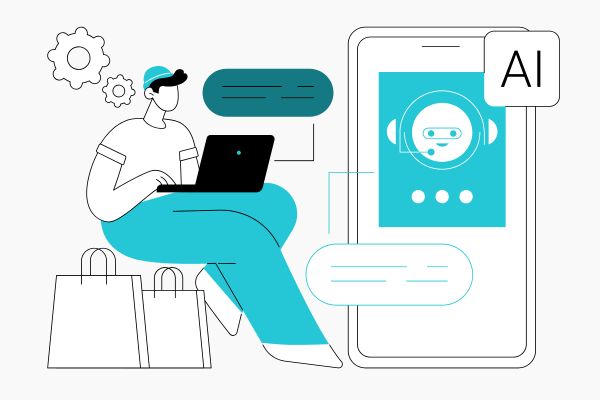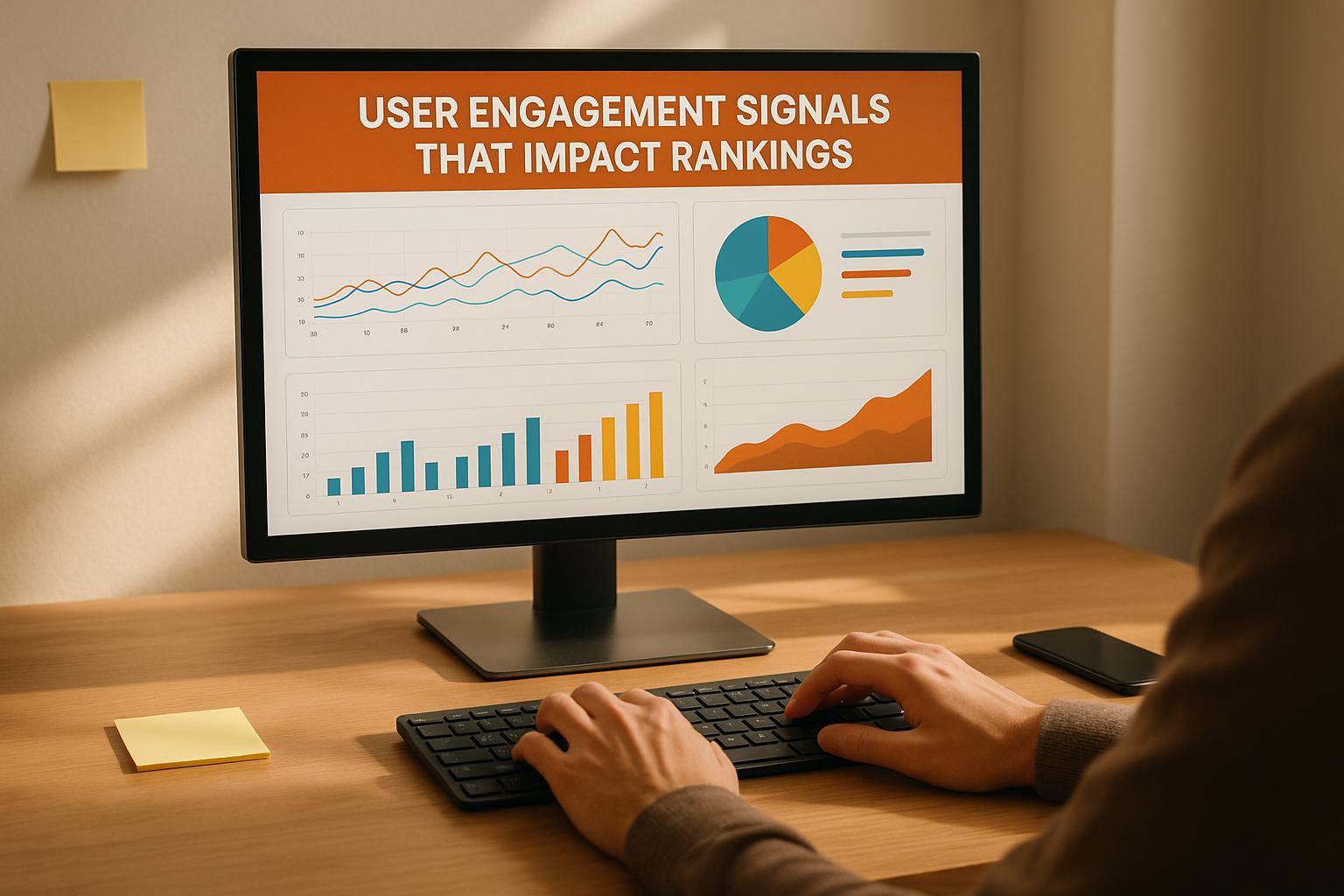

How AI Generates Real-Time Content for A/B Tests

How AI Generates Real-Time Content for A/B Tests
 24-07-2025 (Last modified: 06-08-2025)
24-07-2025 (Last modified: 06-08-2025)
AI has transformed A/B testing into a faster, data-driven process that delivers results in hours instead of weeks. By automating content creation, test execution, and analysis, AI eliminates manual effort and human bias, making optimization more efficient and reliable.
Key takeaways:
- AI generates content variations based on user behavior and historical data.
- Real-time traffic adjustments ensure high-performing variations get more visibility.
- Businesses report an average 20% increase in conversion rates using AI-driven testing.
- Platforms like PageTest.AI simplify A/B testing for small businesses with no-code tools and affordable plans.
AI-powered systems continuously learn from user interactions, enabling dynamic optimization and deeper audience insights. Whether you’re testing headlines or page layouts, AI helps you make smarter decisions and boost conversions faster.
Accelerating A/B Testing & Experimentation with Generative AI Ft. Benjamin Skrainka from Amazon
Key Components of AI-Powered Real-Time A/B Testing
AI-powered real-time A/B testing relies on a set of interconnected systems designed to automatically generate, optimize, and refine content variations. Each component plays a critical role in improving conversion rates by leveraging data-driven insights. Together, they create a streamlined and efficient process for optimization.
Automated Test Idea Generation
AI pinpoints opportunities for optimization by analyzing user interactions and conversion metrics. It digs into patterns like user behavior, conversion funnels, and engagement trends. By gathering data from various digital channels – such as page views, clicks, scrolls, purchases, and session durations – the system identifies subtle patterns, such as time-of-day activity spikes, variations in click behavior, preferences based on referral sources, and device-specific interactions.
For instance, if mobile users frequently abandon their carts at a specific stage, the AI might suggest testing simplified forms or adding alternative payment methods tailored to that audience. This method removes the guesswork from test idea generation, ensuring that recommendations are firmly rooted in real user data.
Once these insights are gathered, the system moves to the next phase: creating actionable content variations.
Creating Multiple Content Variations
AI, powered by machine learning, generates and tests multiple content variations at scale based on predefined criteria. Using large language models, it adapts content to match user behavior and context, ensuring that each variation is highly relevant. This goes beyond simple text changes – AI considers factors like user demographics, browsing history, device type, and even the time of day to craft tailored content.
As the system learns from user interactions, reinforcement learning techniques help it adapt to new trends and audience behaviors. This ensures that the variations tested cover a wide range of scenarios, providing a deeper understanding of what resonates with different users.
Once the variations are ready, the system transitions to smart traffic management.
Smart Traffic Distribution
Traditional A/B testing often splits traffic evenly between variations, but AI takes this a step further with smart traffic distribution. Using algorithms like Multi-Armed Bandit (MAB), the system dynamically adjusts traffic allocation in real time based on performance.
“Instead of keeping traffic split evenly between variations, MAB testing automatically shifts more traffic to the best-performing version while still continuing to explore other variations.”
This method ensures that weak variations receive less traffic, minimizing losses, while high-performing versions are shown to more users. The system also factors in contextual details, such as user behavior, device type, and location, to present each segment with the variation most likely to succeed. With traffic allocated effectively, the focus shifts to tracking performance.
Ongoing Performance Tracking
Continuous monitoring is key to refining optimization efforts. AI systems track performance metrics like conversion rates and click-through rates in real time, quickly identifying any issues that could impact results. By flagging anomalies and using predictive models to forecast user behavior, the system ensures that each user segment receives the most relevant variation.
This ongoing feedback loop can lead to significant improvements. For example, teams have reported capturing an average 15% uplift in conversions that might have otherwise been overlooked. By staying in sync with user preferences and market dynamics, AI ensures that optimization efforts remain effective and responsive to change.
Benefits of AI in Real-Time A/B Testing
AI has revolutionized conversion optimization, making it faster, more precise, and capable of handling larger-scale experiments.
Faster Testing and Broader Reach
AI speeds up the entire testing process by automating each step, from setup to analysis. Traditional A/B tests often require waiting until statistical significance is achieved, but AI-powered tests adapt in real time, delivering quicker results.
With the help of Multi-Armed Bandit (MAB) algorithms, AI shifts traffic toward high-performing variations while minimizing exposure to underperforming ones. This approach not only saves time but also ensures resources are allocated more effectively.
AI also excels in handling complex tests across different audience segments. By analyzing massive datasets in real time, it enables teams to simultaneously optimize multiple elements like headlines, call-to-action buttons, product descriptions, and page layouts. For instance, Amma, a pregnancy tracker app, used MAB algorithms to optimize push notifications, achieving a 12% increase in user retention on both iOS and Android platforms.
This speed and scale open the door to creating more personalized and engaging user experiences.
Enhanced Content Personalization
AI goes beyond basic demographic segmentation to deliver truly individualized experiences. It analyzes user behavior, browsing patterns, device preferences, and even time-of-day activity to serve content tailored to each visitor.
This level of personalization drives higher engagement. AI supports strategies like behavioral targeting, which identifies patterns in user interactions to ensure content aligns with individual interests. It also enables dynamic content adjustments, allowing websites to adapt elements in real time based on user behavior. For example, one company saw an 89% increase in purchases through audience-specific recommendations, while another boosted application submissions by 4.5% by fine-tuning call-to-action elements.
By adapting content in real time, AI not only accelerates testing but also ensures a more personalized experience for every user.
Reduced Manual Effort
AI doesn’t just make testing faster and more personalized – it also lightens the workload. It automates tasks like generating hypotheses, executing tests, and analyzing results, freeing teams to focus on strategic and creative decisions.
Instead of spending hours cleaning data or setting up experiments, teams can dedicate their efforts to interpreting insights and refining strategies. Dynamic traffic allocation further reduces manual intervention, allowing optimization teams to focus on the bigger picture.
A great example of this efficiency is Ashley Furniture. By using an AI-driven solution, they tested a variation that prompted shoppers to enter delivery information immediately after logging in. This change led to a 15% increase in conversion rates and a 4% drop in bounce rates.
sbb-itb-6e49fcd
Setting Up Real-Time AI Testing with PageTest.AI

PageTest.AI brings the power of real-time AI testing right to your fingertips, making website optimization not just possible but straightforward. By removing the technical hurdles that often deter small businesses and marketers, it simplifies A/B testing and makes conversion optimization accessible to everyone.
PageTest.AI Platform Features
PageTest.AI is packed with tools designed to streamline real-time content testing. With its Chrome extension, you can select any element on your live site – like headlines, buttons, or descriptions – without needing to touch a single line of code. Once you’ve made your selection, the AI engine generates up to 10 alternative versions, each crafted to boost visitor engagement.
But that’s just the start. A behavioral analytics engine tracks key metrics like click-through rates, scroll depth, time spent on the page, and conversions, helping you pinpoint the most effective variation. Integration is a breeze, whether you use the WordPress plugin or a simple JavaScript snippet. These tools work seamlessly with platforms like WordPress, Shopify, Wix, Magento, and Squarespace.
The AI-powered Success Engine takes it a step further by continuously analyzing user interactions to highlight the top-performing content versions. With these features, setting up and running tests becomes fast and intuitive, even for those without technical expertise.
How to Set Up Your First Test
Launching your first A/B test is straightforward. Start by installing the Chrome extension and connecting it through either the WordPress plugin or a JavaScript snippet. Then, on your chosen page, click on any text or button element – whether it’s a headline, description, or call-to-action. The interface will instantly provide AI-generated alternatives designed to drive higher engagement.
You can review these suggestions, pick the ones you like, or tweak them to align with your brand’s tone. Once you’ve made your selections, activate the test, and it goes live immediately. A real-time dashboard displays performance metrics, making it easy to track which variation comes out on top. The platform also features a user-friendly test editor, allowing you to manage and preview all your tests directly on your site. This process makes it possible for even small teams to leverage AI for real-time website optimization.
Why PageTest.AI Works Well for Small Businesses
Small businesses often struggle with limited budgets, small teams, and a lack of technical know-how. PageTest.AI addresses these challenges head-on with its no-code approach, eliminating the need for developer support. This is a game-changer, especially considering that nearly 60% of small businesses avoid using AI tools due to their complexity.
The platform’s accessible design and flexible pricing make it a perfect fit for smaller operations. Plans are tiered to grow with your business: the free Trial includes 10,000 impressions, 5 pages, and 5 tests; the $10/month Startup plan doubles those limits; and the $50/month Enterprise plan offers 100,000 impressions, covering 100 pages and up to 10 websites.
With a 5.0-star rating on both Product Hunt and the Chrome Web Store, and glowing user reviews praising its ease of use and reliability, PageTest.AI proves itself as a tool that small businesses can trust. By automating content generation and test management, it empowers small business owners to compete effectively with larger companies while maintaining the agility they need to thrive.
Best Practices for Better Conversion Rate Optimization
To get the most out of AI-driven A/B testing, focus on selecting impactful elements, setting clear goals, and leveraging real-time data. These practices align perfectly with AI’s ability to automate and analyze data for better results. The next step? Pinpoint the website elements that generate the highest conversions.
Picking the Right Elements to Test
Start with high-impact components like headlines, images, and call-to-action (CTA) buttons – these are the elements that directly shape visitor decisions and affect your revenue.
Take headlines, for example. Small tweaks can yield big results. One case showed that adding the word “supplement” to a headline increased conversions by an impressive 89%. Similarly, swapping static product images for 360-degree views boosted a retailer’s average order value by 10.4%. For CTAs, experiment with color, size, placement, and wording to see what resonates most. When it comes to forms, try reducing unnecessary fields or using a multi-step format to lower abandonment rates.
Don’t overlook the importance of text length and format. Test benefit-focused headlines against feature-driven ones, or compare concise lists with detailed paragraphs. While shorter copy often drives quicker decisions, longer descriptions can help build trust and credibility.
Setting Clear Goals and Metrics
Before diving into tests, define specific and measurable objectives. Instead of vague goals like “improve conversions”, aim for something concrete – such as “increase cart completions by 15% within 30 days.”
It’s also crucial to align your teams – marketing, product, and design – on metrics that tie directly to business outcomes, like revenue growth or customer retention. For instance, Bimago used AI to personalize homepage banners based on visitor behavior and device type, leading to a 44% increase in email signups and higher on-page engagement. Similarly, Plasto 2027 segmented users by engagement levels, resulting in a 35% boost in click-through rates and a 21% rise in renewals.
Focus on primary metrics that directly impact your goals, while keeping an eye on secondary metrics like bounce rates or time spent on a page. These additional insights can help fine-tune your approach as you gather more data.
Using Real-Time Data to Improve Results
AI-powered testing generates a wealth of real-time data, which, when analyzed effectively, can lead to actionable insights. Multi-armed bandit (MAB) algorithms, for instance, dynamically shift traffic toward better-performing variations during tests, ensuring that more visitors experience the most successful versions.
AI doesn’t just stop there – it can identify sub-segments where certain variations perform exceptionally well. Teams have reported a 15% improvement in outcomes they might have missed otherwise. Combining this quantitative data with qualitative feedback helps refine hypotheses for future tests.
Continuous monitoring is key because user preferences and market conditions are always shifting. AI tools can instantly flag changes or new opportunities. For example, Toyota’s digital team replaced manual lead scoring with AI-powered visitor targeting, saving time and improving precision. Julien Descombes, Digital Communication Manager at Toyota, shared:
“Until now, we carried out manual scoring of our visitors to determine the quality of the leads we then sent to our dealers. Kameleoon’s AI outperforms this manual scoring by targeting visitors precisely according to their interest in particular models, and also saves us a lot of time.”
Lastly, AI can perform meta-analyses of past test results, uncovering patterns of success and failure. By applying these insights, you can prioritize future tests and fine-tune your overall website and marketing strategies.
Conclusion
AI-powered content generation is revolutionizing the way businesses approach A/B testing, turning what was once a slow, manual process into a fast-moving, automated system. From generating hypotheses to distributing traffic and analyzing results, AI streamlines every step. It also uncovers insights that traditional methods simply can’t match. This shift enables smarter, data-driven decisions that constantly refine your website’s performance.
Real-world examples have shown how companies achieve impressive conversion gains through AI-driven testing. These aren’t just isolated wins – they’re becoming the standard for businesses willing to embrace AI’s potential.
One of AI’s biggest strengths is its ability to process massive datasets at incredible speed, spotting subtle patterns that humans might overlook. Tools like Multi-Armed Bandit algorithms can even adjust traffic allocation in real time, ensuring the best-performing variations get more attention without waiting for weeks of testing. This means your website evolves and improves continuously, even when you’re not actively managing it.
Platforms like PageTest.AI make this process even more accessible. With its no-code interface, AI-generated content variations, real-time tracking, and compatibility with popular website builders, it’s easier than ever to stay competitive in today’s fast-paced market.
Jon MacDonald, CEO of The Good, highlights the impact of AI on testing workflows:
“Since we build rapid prototypes quite often, using AI has helped us code A/B tests faster and without bugs. We’re able to produce rapid prototypes quickly, increasing our testing volume and rapidly validating hypotheses.”
The reality is clear: AI has already reshaped conversion optimization. The real question is whether your business will take advantage of these tools. By automating tasks, delivering faster insights, and enabling data-driven decisions, AI can directly boost your bottom line. With platforms like PageTest.AI bringing these capabilities to businesses of all sizes, there’s no better time to rethink your approach to conversion rate optimization.
FAQs
How does AI create content variations that resonate with different user groups?
AI uses detailed behavioral and demographic data to craft content variations that cater to specific user groups. By analyzing patterns and preferences within these segments, it can create personalized content that matches the unique characteristics and needs of each audience.
This approach helps ensure the content is not just relevant but also more engaging, boosting user interaction and increasing the chances of better conversion rates and stronger overall results.
What advantages does AI-driven A/B testing offer over traditional methods?
AI-powered A/B testing brings several standout benefits compared to traditional methods. For starters, it delivers quicker results by automating the process of creating and analyzing content variations. This means you can test multiple elements – like headlines or images – at the same time, without needing to manually manage each step. The result? You save time while maintaining constant improvement, as the AI adjusts and learns from user behavior in real time.
Another advantage is the broader testing scope AI offers. You can experiment with a wider range of variables, such as calls-to-action (CTAs), product descriptions, or even layout designs, all while targeting different audience segments. On top of this, AI provides tailored insights that help you make smarter, data-backed decisions to align with your users’ preferences. This leads to better conversion rates and stronger overall performance. It’s clear that AI has become an essential tool for modern A/B testing and optimizing websites.
How can small businesses use AI for real-time A/B testing without needing technical skills?
Small businesses can tap into the power of AI-driven real-time A/B testing using no-code platforms that make the entire process straightforward. These platforms take care of everything – from crafting content variations to breaking down performance metrics – without the need for any technical know-how.
With AI-powered tools, tasks like brainstorming test ideas, conducting experiments, and analyzing results are fully automated. This means businesses can zero in on refining crucial website elements, such as headlines, call-to-actions (CTAs), and product descriptions, to drive better engagement and higher conversion rates with ease.
Related posts
say hello to easy Content Testing
try PageTest.AI tool for free
Start making the most of your websites traffic and optimize your content and CTAs.
Related Posts

 13-12-2025
13-12-2025
 Becky Halls
Becky Halls
The Biggest Marketing Shifts Coming in 2026: What Actually Matters Now
2026 isn’t bringing “the future of marketing.” It’s bringing the correction. The dust is finally settling after years of AI noise, platform changes, and search unpredictability. And we’re now seeing what actually sticks, and the shifts that will shape how marketing teams operate for the next decade… These aren’t trends for trends’ sake. They’re structural […]

 13-12-2025
13-12-2025
 Ian Naylor
Ian Naylor
User Engagement Signals That Impact Rankings
How CTR, dwell time, bounce rate and pages-per-session influence SEO rankings — and practical steps (UX, titles, testing) to improve engagement.

 12-12-2025
12-12-2025
 Ian Naylor
Ian Naylor
AI-Driven Mobile Segmentation with Real-Time Data
AI mobile segmentation turns real-time behavioral, contextual, and transactional signals into dynamic user groups that boost personalization, retention, and conversions.
